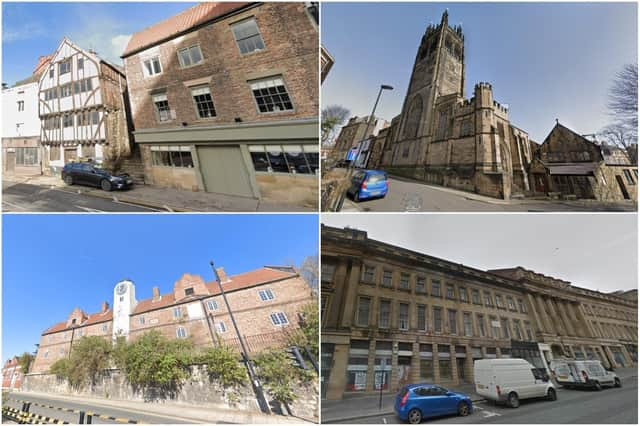Heritage At Risk Register 2023: The Newcastle buildings and conservation areas at risk of being lost


The annual Heritage at Risk register, which offers an update on buildings and areas around the country that are most at risk from being lost, has been released.
Used as a part of the UK Government’s official statistics, the register highlights cultural assets which are at risk through neglect, decay or development which is inappropriate for the area according to Heritage England.
Advertisement
Hide AdAdvertisement
Hide AdGrade one listed buildings and registered parks and gardens are covered by the register, in addition to scheduled monuments, historic battlefields, protected wreck sites and conservation areas which are considered to be at risk.
Grade two listed buildings of religious significance are also included in the register which began in the mid 1980s.
England. Scotland, Wales and Northern Ireland have their own registers.
Advertisement
Hide AdAdvertisement
Hide AdThe most well known of these can be found on the Quayside at The Cooperage. Originally a merchant house and more recently a public house and restaurant, the medieval grade two listed building is deteriorating due to a lack of maintenance.
Another spot overlooking the river which is considered to be at risk is Keelmen's Hospital. Although options for re-use are being explored according to the register, the building remains vacant and disused and is at risk of slow decay.
Heading further into the city, an iconic part of Newcastle is said to be at risk with a section of Grey Street said to also have issues with rot and decay. The future of the four storey shops from number 5 to 13 on the west side of the street are currently being discussed with measures to prevent and repair rot said to be vital.
Shieldfield is also home to an at-risk building according to the register. The roofs of Christ Church and the attached hall on the Green are reaching the end of their lifespan and, although work was done in 2015 to secure the structure of the roof, a second phase is needed with funding talks underway.
Advertisement
Hide AdAdvertisement
Hide AdHead from the city up Westgate Road, and you will be able to spot a series of at risk areas in close proximity to each other. The Church of St Matthew has external stonework issues which is soon to be worked on while the nearby Life Transformation Church is needing further repairs after years of no use. Although work has been done on the structure, more is needed to secure its survival.
Connecting the two sites is Westgate Hill Cemetery – a registered conservation area – where a conservation management plan is in place to remove invasive weeds and look to reduce anti social behaviour on the site.
A nearby cemetery, St John’s, is also at risk due to damage to steps around the area in addition to the poor state of some memorials and crumbling boundary walls. The local St Michael's Church has also been listed due to a deterioration of the site’s presbytery.
Two churches on the outskirts of the city centre are also said to be at risk with the Church of St Michael with St Lawrence in Byker and the Church of St Luke near the Town Moor both listed on the register. Although work has been carried out on both, damp has lingered in the North Tyneside site while the Church of St Luke is being repaired in order for worship to return to the church.
Advertisement
Hide AdAdvertisement
Hide AdFurther up the Tyne in Wallsend, the St Peter’s area of the town and its three listed buildings are said to be at risk. The conservation area is listed as being in “very bad” condition. The area includes a church and school of the same name, alongside the Osborne House retirement home.
To the south of the river there are concerns for Dunston Staiths, a wooden structure which used to load coal from Durham’s coalfields into ships. The site has suffered from three fires – most recently in 2020 – since its closure in 1970 and Gateshead Council are working with Historic England and the National Trust to ensure the safety of the historic frame.
The remains of the mining site at Dunston Hill are also considered to be at risk according to the register. The site, which has been used to mine coal since the 17th century, is seen as an archaeological site which sees local road construction put it at risk. Heritage England are considering the site to see a trending decline.
Also in Gateshead, the Church of St Chad on Rawling Road is listed due to the roof, which was partially repaired in 2016 with more work needed to the structure. Water infiltrating the building is another listed issue for the site.
Advertisement
Hide AdAdvertisement
Hide AdElsewhere in the area, sites near Throckley which house stretches of Hadrian’s Wall are conservation sites where nearby ploughing could impact the structural integrity of the historic wall, while the battlefield of the Battle of Newburn Ford also at risk due to development in the area.
A report has been created to ensure the historical significance of the area is considered during planning phases.
Nearby Dewley Hill is also listed on the register due to prehistoric finds in the area while Woolsington Hall near Newcastle Airport is also on the list. The building is considered to bein “very bad condition although the owners of the site are now carrying out stabilisation and repair works to make the structure wind and weather tight.